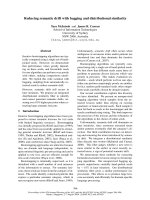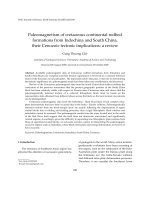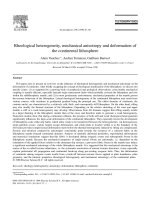Continental drift and seafloor spreading
Bạn đang xem bản rút gọn của tài liệu. Xem và tải ngay bản đầy đủ của tài liệu tại đây (2.18 MB, 34 trang )
Today’s Lecture:
Chaps. 3 & 4
Continental Drift & Seafloor Spreading
In Lecture Today:
1. Alfred Wegener and the hypothesis of
continental drift.
2. Evidence supporting continental drift.
3. Hypothesis of polar wandering.
4. Discoveries leading up to the hypothesis
seafloor spreading.
-
Major features of the seafloor.
5. Rock magnetism - a review.
6. Tests of the seafloor spreading hypothesis.
Continental
Drift
Historical Development
1915
Alfred Wegener published
his hypothesis of
continental drift
He hypothesized:
existence of single
“super-continent”
Pangaea (“pan - G - uh”)
~ 200 million years ago Pangaea broke into
smaller pieces, which “drifted” to their present positions
200 million years ago
P
A
U
A
L
R
A
A
I
S
N
G
GO
N
A
DW
AN
AL
AN
D
E
A
MOVIE
CONTINENTAL
DRIFT
Historical development
Evidence from rocks:
Mountain belts on one continent match up to the rocks found
on another continent.
Example: Rocks of similar age & structure
are found in the:
Appalachians (eastern US)
British Isles, Scandanavia
CONTINENTAL
DRIFT
Historical development
Paleoclimate evidence
Gondwanaland glacial deposits are today scattered
around on different continents…
CONTINENTAL
DRIFT
Historical development
Paleoclimate evidence
(ancient)
…but when Pangea is reassembled, these
glacial deposits all match up perfectly!
CONTINENTAL
DRIFT
Historical development
Fossil Evidence
Distributions of many fossil species found on different
continents only make sense in light of continental drift
Mesosaurus
Lystrosaurus
How can the same species
evolve on widely separated
continents???
Jurassic Aquatic Reptile, Mesosaurus
Mammal-like reptile, Lystrosaurus
CONTINENTAL
DRIFT
Historical development
1924
Alfred Wegener’s book translated to English, and was
greeted with (to put it politely) hostile criticism!
Main objections:
There was no clear drift mechanism and thus,
no way to explain how continents could “plow” their way
through the seafloor.
The seafloor was believed to be static, fixed
and very old. Radiometric dating was not developed
until the 1950’s. Most of our knowledge of the seafloor was
based on original surveys by the HMS Challenger
global expedition carried out during the 1850’s.
CONTINENTAL
DRIFT
Historical Development
Alfred Wegener’s continental drift idea died until
1950’s, when the field of military oceanography
began to mature. New discoveries on the seafloor
lead to the hypothesis of seafloor spreading
proposed by American scientists, Hess and Dietz.
During the 1970’s, the hypothesis of seafloor
spreading was tested using discoveries in the field of
rock magnetism by two british scientists, Vine and
Matthews (1963).
Remnant magnetism: The orientation of the magnetic field of
the Earth is recorded by the magnetic minerals found
in igneous rocks. It is in this way that scientists learned about
periodic reversals of the polarity of the field.
CONTINENTAL
DRIFT
Historical Development
Concept of “Polar wandering”
•Discovered in the 1950’s.
•Based on measuring the remnant magnetic field preserved in
rocks
•Using the dip angle of the remnant magnetic field preserved
in rocks, it was possible to infer the position of the pole at the
time the rocks formed.
•These studies lead to the discovery of polar wandering,
which suggested that either 1) the poles have “wandered” or
2) the continents have drifted.
CONTINENTAL
DRIFT
Rock Magnetism
Basics:
-Certain minerals are magnetic (e.g., magnetite, iron)
-They loose magnetization when heated above Curie
point (580oC for iron)
-When cooled below Curie pt, magnetic grain aligns
w/ Earth’s magnetic field
Rock Magnetism
Basics:
The dip angle of the
remnant magnetic
field preserved in
a rock indicates the
latitude where
it formed!
Iceland
Mid-Atlantic Ridge
Discovering the nature of the seafloor:
The advent of military oceanography
Mapping the ocean floor
Methods:
Sonar (echoes of sound waves)
Satellite radar
The World’s Mid-Ocean Ridges
Mid-ocean ridges
Longest continuous
mountain range on
Earth (70,000 km long!)
Elevated 2-3 km
above ocean basins.
Composed of young,
basaltic lavas
Peru-Chile Trench
Mid-ocean ridges
The shape of the seafloor:
Topographic profile across the
East Pacific Rise.









